Taxidermy

Taxidermy is the preserving of an animal's body via stuffing or mounting for the purpose of display or study. Animals are often, but not always, portrayed in a life-like state. The word taxidermy refers to the process of preserving the animal, but the word is also used to describe the end product, which are often called "mounts". The word taxidermy is derived from the Greek words "taxis" and "derma". Taxis means to "to move", and "derma" means "skin" (the dermis). The word taxidermy translates to "arrangement of skin".[1] Taxidermy is practiced primarily on vertebrates[2] (mammals, birds, fish, reptiles, and less commonly on amphibians) but can also be done to larger insects and arachnids[3] under some circumstances. Taxidermy takes on a number of forms and purposes, including natural history museum displays, hunting trophies, study skins, and is sometimes used as a means to memorialize pets.[4] A person who practices taxidermy is called a taxidermist. They may practice professionally for museums or as businesses catering to hunters and fishermen, or as amateurs, such as hobbyists, hunters, and fishermen. A taxidermist is aided by familiarity with anatomy, sculpture, painting, and tanning.

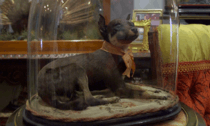 | |
|
|
History

Tanning and early stuffing techniques
Preserving animal skins has been practiced for a long time. Embalmed animals have been found with Egyptian mummies.
Although embalming incorporates the use of lifelike poses, it is not considered taxidermy. In the Middle Ages, crude examples of taxidermy were displayed by astrologers and apothecaries. The earliest methods of preservation of birds for natural history cabinets were published in 1748 by Reaumur in France. Techniques for mounting were described in 1752 by M. B. Stollas. There were several pioneers of taxidermy in France, Germany, Denmark and England around this time. For a while, clay was used to shape some of the soft parts, but this made specimens heavy.
By the 18th century, almost every town had a tannery business. In the 19th century, hunters began bringing their trophies to upholstery shops, where the upholsterers would actually sew up the animal skins and stuff them with rags and cotton. The term "stuffing" or a "stuffed animal" evolved from this crude form of taxidermy. Professional taxidermists prefer the term "mounting" to "stuffing". More sophisticated cotton-wrapped wire bodies supporting sewn-on cured skins soon followed. In France, Louis Dufresne, taxidermist at the Muséum national d'Histoire naturelle from 1793, popularized arsenical soap in an article in Nouveau dictionnaire d'histoire naturelle (1803–1804). This technique enabled the museum to build the greatest collection of birds in the world.
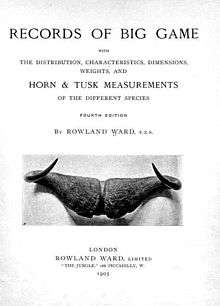
Dufresne's methods spread to England in the early 19th century, where updated and non-toxic methods of preservation were developed by some of the leading naturalists of the day, including Rowland Ward and Montague Brown. Ward established one of the earliest taxidermy firms, Rowland Ward Ltd. of Picadilly. However, the art of taxidermy remained relatively undeveloped, and the specimens that were created remained stiff and unconvincing.
Taxidermy as art
The golden age of taxidermy was during the Victorian era, when mounted animals became a popular part of interior design and decor.[5] The father of modern taxidermy is considered to be John Hancock, an English ornithologist. An avid collector of birds, which he would shoot himself, he began modelling them with clay and casting in plaster.
For the Great Exhibition of 1851 in London, he mounted a series of stuffed birds as an exhibit. They generated much interest among the public and scientists alike who considered them as superior to earlier models and were regarded as the first lifelike and artistic specimens on display.[6] A judge remarked that Hancock's exhibit "... will go far towards raising the art of taxidermy to a level with other arts which have hitherto held higher pretensions".[7]
Hancock's display sparked great national interest in taxidermy, and amateur and professional collections for public view proliferated rapidly. Displays of birds were particularly common in middle-class Victorian homes - even Queen Victoria amassed an impressive bird collection. Taxidermists were also increasingly used by the bereaved owners of dead pets to 'resurrect' them.[8]
Anthropomorphic taxidermy

In the late 19th century a style known as anthropomorphic taxidermy became popular. A 'Victorian whimsy', mounted animals were dressed as people or displayed as if engaged in human activities. An early example of this genre was displayed by Herman Ploucquet, from Stuttgart, Germany, at the Great Exhibition in London.[9]
The best-known practitioner in this genre was the English taxidermist Walter Potter, whose most famous work was The Death and Burial of Cock Robin. Among his other scenes were "a rat's den being raided by the local police rats ... [a] village school ... featuring 48 little rabbits busy writing on tiny slates, while the Kittens' Tea Party displayed feline etiquette and a game of croquet."[10] Apart from the simulations of human situations, he had also added examples of bizarrely deformed animals such as two-headed lambs and four-legged chickens. Potter's museum was so popular that an extension was built to the platform at Bramber railway station.[11]
Famous examples of modern anthropomorphic taxidermy include the work of artist Adele Morse who gained international attention with her "Stoned Fox" sculpture series[12] and the work of artist Sarina Brewer, known for her Siamese twin squirrels and flying monkeys partaking in human activities.[13]
20th century
.jpg)

In the early 20th century, taxidermy was taken forward under the leadership of artists such as Carl Akeley, James L. Clark, William T. Hornaday, Coleman Jonas, Fredrick and William Kaempfer, and Leon Pray. These and other taxidermists developed anatomically accurate figures which incorporated every detail in artistically interesting poses, with mounts in realistic settings and poses that were considered more appropriate for the species. This was quite a change from the caricatures popularly offered as hunting trophies.
Museums use taxidermy as a method to preserve a record of specimens of extinct and threatened species.[14]
Rogue taxidermy
Rogue Taxidermy (sometimes referred to as "taxidermy art"[15]) is a genre of mixed media sculpture.[13][16] Rogue Taxidermy art references traditional trophy or natural history museum taxidermy, but is not always constructed out of taxidermied animals,[13][16] it can be constructed entirely from synthetic materials.[13] Additionally, rogue taxidermy is not necessarily figurative, it can be abstract and does not need to resemble an animal.[13] It can be a small decorative object or a large-scale room-sized installation. There is a very broad spectrum of styles within the genre, some of which falls into the category of mainstream art.[13] Neither the term, nor the genre, emerged from the world of traditional taxidermy.[16] The genre was born from forms of fine art that utilize some of the components found in the construction of a traditional taxidermy mount.[16]
"Traditional taxidermy has never been associated with a [fine] art movement" . . . "This stands in stark contrast to Rogue Taxidermy, which began as a fine art movement. While some pieces of Rogue Taxidermy art can certainly echo traditional taxidermy (i.e., by using organic animal materials), Rogue Taxidermy art does not need to include actual animal remains. As such, [the genre of] Rogue Taxidermy is not a subcategory of traditional [skin-mount] taxidermy. . ." [16]
The term "Rogue Taxidermy" was coined by a Minneapolis-based artist collective called The Minnesota Association of Rogue Taxidermists (MART) in October 2004.[17] The term was invented by MART founders Sarina Brewer, Scott Bibus, and Robert Marbury to collectively describe their respective styles of sculpture.[17] The definition of Rogue Taxidermy, as set forth by the individuals who invented the term and formed the genre (Brewer, Bibus, and Marbury), is: "A genre of pop-surrealist art characterized by mixed media sculptures containing conventional taxidermy-related materials that are used in an unconventional manner".[15][18] Per these stated parameters, anthropomorphic taxidermy mounts (such as those created by taxidermist Walter Potter) and mounts of fictional animals (such as the jackalope), fall under the category of Rogue Taxidermy because they consist of "conventional taxidermy-related materials being presented in an unconventional manner", however, that is not all the genre encompasses nor is rogue taxidermy defined merely as such.[18]The term "Rogue Taxidermy" first appeared in print in a New York Times article about the group's debut exhibition on January 3, 2005.[19] and has not been documented in use elsewhere prior to that date.
Methods
Traditional skin-mount
The methods taxidermists practice have been improved over the last century, heightening taxidermic quality and lowering toxicity. The animal is first skinned in a process similar to removing the skin from a chicken prior to cooking. This can be accomplished without opening the body cavity, so the taxidermist usually does not see internal organs or blood. Depending on the type of skin, preserving chemicals are applied or the skin is tanned. It is then either mounted on a mannequin made from wood, wool and wire, or a polyurethane form. Clay is used to install glass eyes. Forms and eyes are commercially available from a number of suppliers. If not, taxidermists carve or cast their own forms.
Taxidermists seek to continually maintain their skills to ensure attractive, lifelike results. Mounting an animal has long been considered an art form, often involving months of work; not all modern taxidermists trap or hunt for prize specimens.[20]
Animal specimens can be frozen, then thawed at a later date to be skinned and tanned. Numerous measurements are taken of the body. A traditional method that remains popular today involves retaining the original skull and leg bones of a specimen and using these as the basis to create a mannequin made primarily from wood wool (previously tow or hemp wool was used) and galvanised wire. Another method is to mould the carcass in plaster, and then make a copy of the animal using one of several methods. A final mould is then made of polyester resin and glass cloth, from which a polyurethane form is made for final production. The carcass is then removed and the mould is used to produce a cast of the animal called a 'form'. Forms can also be made by sculpting the animal first in clay. Many companies produce stock forms in various sizes. Glass eyes are then usually added to the display, and in some cases, artificial teeth, jaws, tongue, or for some birds, artificial beaks and legs can be used.
Freeze dried mount
An increasingly popular trend is to freeze dry the animal. For all intents and purposes, a freeze-dried mount is a mummified animal that still has fur on it. The internal organs are removed during preparation; however, all other tissue remains in the body. (The skeleton and all accompanying musculature is still beneath the surface of the fur.) The animal is positioned into the desired pose, then placed into the chamber of a special freeze drying machine designed specifically for this application. The machine freezes the animal and also creates a vacuum in the chamber. Pressure in the chamber helps vaporize moisture in the animal's body, allowing it to dry out. The rate of drying depends on vapor pressure. (The higher the pressure, the faster the specimen dries.)[21] Vapor pressure is determined by temperature of the chamber; the higher the temperature, the higher the vapor pressure is at a given vacuum.[21] The length of the dry-time is important because rapid freezing creates less tissue distortion (i.e.; shrinkage, warping, and wrinkling)[21] The process can be done with reptiles, birds, and small mammals such as cats, rodents, and some dogs. Large specimens may require up to six months in the freeze dryer before they are completely dry. Freeze drying is the most popular type of pet preservation. This is because it is the least invasive in terms of what is done to the animal's body after death, which is a concern of owners (Most owners do not opt for a traditional skin mount). In the case of large pets, such as dogs and cats, freeze dying is also the best way to capture the animal's expression as it looked in life (another important concern of owners). Freeze drying equipment is costly and requires much upkeep. The process is also time-consuming; therefore, freeze drying is generally an expensive method to preserve an animal. The drawback to this method is that freeze-dried mounts are extremely susceptible to insect damage. This is because they contain large areas of dried tissue (meat and fat) for insects to feed upon. Traditional mounts are far less susceptible because they contain virtually no residual tissues (or none at all). Regardless of how well a taxidermy mount is prepared, all taxidermy is susceptible to insect damage. Taxidermy mounts are targeted by the same beetles and fabric moths that destroy wool sweaters and fur coats and that infest grains and flour in pantries.
Reproduction mount
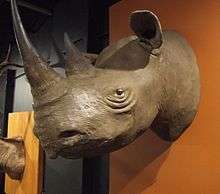
Some methods of creating a trophy mount do not involve preserving the actual body of the animal. Instead, detailed photos and measurements are taken of the animal so a taxidermist can create an exact replica in resin or fiberglass that can be displayed in place of the real animal. No animals are killed in the creation of this type of trophy mount. One situation where this is practiced is in the world of sport fishing where catch and release is becoming increasingly prevalent. Reproduction mounts are commonly created for (among others) trout, bass, and large saltwater species such as the swordfish. Another situation where reproduction trophies are created is when endangered species are involved. Endangered and protected species, such as the rhinoceros, are hunted with rifles loaded with tranquilizer darts rather than real bullets. While the animal is unconscious, the hunter poses for photos with the animal while it is measured for the purpose of creating a replica, or to establish what size of prefabricated fiberglass trophy head can be purchased to most closely approximate the actual animal. The darted animal is not harmed. The hunter then displays the fiberglass head on the wall in lieu of the real animal's head to commemorate the experience of the hunt.
Re-creation mount
Re-creation mounts are accurate life-size representations of either extant or extinct species that are created using materials not found on the animal being rendered. They utilize the fur, feathers, and skin of another species of animal. According to the National Taxidermy Association: "Re-creations, for the purpose of this [competition] category, are defined as renderings which include no natural parts of the animal portrayed. A re-creation may include original carvings and sculptures. A re-creation may use natural parts, provided the parts are not from the species being portrayed. For instance, a re-creation eagle could be constructed using turkey feathers, or a cow hide could be used to simulate African game".[22] A famous example of a re-creation mount is a giant panda created by taxidermist Ken Walker that he constructed out of dyed and bleached black bear fur.[23]
Study skins
A study skin is a taxidermic specimen prepared in a minimalistic fashion that is concerned only with preserving the animal's skin, not the shape of the animal's body.[24] As the name implies, study skins are used for scientific study (research), and are housed mainly by museums. A study skin's sole purpose is to preserve data, not to replicate an animal in a life-like state.[24] Museums keep large collections of study skins in order to conduct comparisons of physical characteristics to other study skins of the same species. Study skins are also kept because DNA can be extracted from them when needed at any point in time.[25]
A study skin's preparation is extremely basic. After the animal is skinned, fat is methodically scraped off the underside of the hide. The underside of the hide is then rubbed with borax or cedar dust to help it dry faster. The animal is then stuffed with cotton and sewn up. Mammals are laid flat on their belly. Birds are prepared lying on their back. Study skins are dried in these positions to keep the end product as slender and streamlined as possible so large numbers of specimens can be stored side-by-side in flat file drawers, while occupying a minimum amount of space. Since study skins are not prepared with aesthetics in mind they do not have imitation eyes like other taxidermy, and their cotton filling is visible in their eye openings.
- 1. Measurements are collected
- 2. Animal is Skinned. Notes on internal organs are recorded
- 3. Skin is stuffed with cotton
- 4. Completed study skin is labeled with a data tag
Notable taxidermists
- Carl Akeley
- Norman Bates (fictional character)
- Jean-Baptiste Bécœur, inventor of arsenical soap
- William Temple Hornaday
- Martha Maxwell
- Charles Johnson Maynard
- Charles Wilson Peale
- Walter Potter
- Theodore Roosevelt
- Alfredo Salafia
- Jules Verreaux
- James Rowland Ward
Gallery
Mammals

_(14755035072).jpg) Elephant, private collection of C. V. A. Peel
Elephant, private collection of C. V. A. Peel Badger, Muséum de Toulouse
Badger, Muséum de Toulouse

_specimen%2C_Kelvingrove_Museum%2C_Glasgow_-_geograph.org.uk_-_1108288.jpg) Wolf, Kelvingrove Museum, Glasgow
Wolf, Kelvingrove Museum, Glasgow Kit fox (Vulpes macrotis), San Diego Natural History Museum
Kit fox (Vulpes macrotis), San Diego Natural History Museum Platypus (Ornithorhynchus anatinus)
Platypus (Ornithorhynchus anatinus).jpg) Two stuffed lar gibbons (Hylobates lar), Naturalis Leiden
Two stuffed lar gibbons (Hylobates lar), Naturalis Leiden


Birds
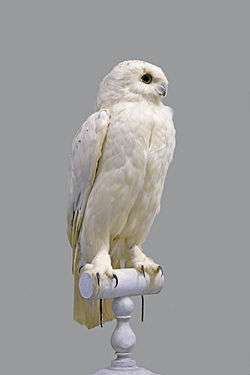 Snowy owl, Muséum de Toulouse
Snowy owl, Muséum de Toulouse Male grey peacock-pheasant, Museum fur Naturkunde, Berlin
Male grey peacock-pheasant, Museum fur Naturkunde, Berlin
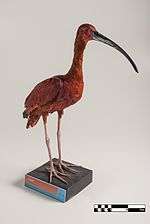 Scarlet ibis, Museum of Veterinary Anatomy, University of São Paulo
Scarlet ibis, Museum of Veterinary Anatomy, University of São Paulo
Fish
 Diodon holocanthus Linnaeus, Siebold collection, 1825
Diodon holocanthus Linnaeus, Siebold collection, 1825
- Angolan dentex, Dentex angolensis
Taxidermists
 Theodore Roosevelt, also 26th US President
Theodore Roosevelt, also 26th US President
See also
- Conservation and restoration of taxidermy
- Taxidermy art and science
- History of Taxidermy
- Plastination
- Barnum's American Museum
References
- ↑ Harper, Douglas. "taxidermy". Online Etymology Dictionary. Retrieved 17 July 2010.
- ↑ Stephen P. Rogers; Mary Ann Schmidt; Thomas Gütebier (1989). An Annotated Bibliography on Preparation, Taxidermy, and Collection Management of Vertebrates with Emphasis on Birds. Carnegie Museum of Natural History. ISBN 978-0-911239-32-4.
- ↑ Daniel Carter Beard (1890). The American Boys Handy Book. C. Scribner's Sons. pp. 242, 243.
- ↑ Pierce Ph.D, Jessica. "All Dogs Go to Heaven". Psychology Today. Sussex Publishers, LLC. Retrieved 2 March 2017.
- ↑ Davie, Oliver (1900). Methods in the art of taxidermy. Philadelphia: David McKay.
- ↑ "John Hancock: A Biography by T. Russell Goddard (1929)".
- ↑ "Taxidermy Articles".
- ↑ "Morbid Outlook - Memento Mori Animalia".
- ↑ Henning, Michelle (2007). "Anthropomorphic taxidermy and the death of nature: The curious art of Hermann Ploucquet, Walter Potter and Charles Waterton." (PDF). Victorian Literature and Culture. 35 (2): 663–678. doi:10.1017/S1060150307051704.
- ↑ Morris, Pat (7 December 2007). "Animal magic". The Guardian. London. Retrieved 2009-02-14.
- ↑ Ketteman, Tony. "Mr Potter of Bramber". Retrieved 2009-02-14.
- ↑ Robert Marbury (2014). Taxidermy Art: A Rogue's Guide to the Work, the Culture, and How to Do It Yourself. Artisan. p. 14. ISBN 978-1-57965-558-7.
- 1 2 3 4 5 6 Rivera, Erica (8 April 2016). "Crave Profile: Sarina Brewer and Rogue Taxidermy". CraveOnline. CraveOnlineLLC. Retrieved 12 December 2016.
- ↑ "Life After Death: Extinct Animals Immortalized With Taxidermy". video.nationalgeographic.com. Retrieved 2015-07-16.
- 1 2 Ode, Kim (15 October 2014). "Rogue Taxidermy, at the crossroads of art and wildlife". Variety section. Star Tribune. Retrieved 12 December 2016.
- 1 2 3 4 5 Lundy, Patricia (16 February 2016). "The Renaissance of Handcrafts and Fine Arts Celebrates Dark Culture". Dirge magazine. Dirge Magazine. Retrieved 3 November 2016.
- 1 2 Voon, Claire (14 October 2014). "Women Are Dominating the Rogue Taxidermy Scene". Vice (magazine). Retrieved 21 December 2016 – via vice.com.
- 1 2 "The History of Rogue Taxidermy". The Taxidermy Art of Sarina Brewer. Retrieved 12 December 2016.
- ↑ Topcik, Joel. "Head of Goat, Tail of Fish, More Than a Touch of Weirdness". The New York Times. January 3, 2005 Page 2.
- ↑ Morgan Mathews (director) (2005). Taxidermy: Stuff the World (documentary film). Century Films.
- 1 2 3 "Feeze Dry Taxidermy". www.freezedryco.com. www.freezedryco.com. Retrieved 5 May 2017.
- ↑ "World Taxidermy Competition categories". www.Taxidermy.net. Breakthrough Magazine, Inc. 2015. Retrieved 13 December 2016.
- ↑ Rowell, Meloday (14 September 2014). "Exotic, Extinct, and On Display: Robert Clark’s Take on Taxidermy". www.NationalGeographic.com. National Geographic Partners, LLC. Retrieved 13 December 2016.
- 1 2 "Study Skins". www.ciMuseums.org.uk. Colchester & Ipswich Museums. Retrieved 13 December 2016.
- ↑ Kurihara, Nozomi (11 February 2013). "Utility of hair shafts from study skins for mitochondrial DNA analysis". Biolotechnology Information. 12 (4): 5396–404. PMID 24301912. doi:10.4238/2013.November.11.1.
Further reading
- Rookmaaker, L. C.; et al. (2006). "The ornithological cabinet of Jean-Baptiste Bécoeur and the secret of the arsenical soap" (PDF). Archives of Natural History. 33 (1): 146–158. doi:10.3366/anh.2006.33.1.146.
External links
| Library resources about Taxidermy |
| Wikimedia Commons has media related to Taxidermy. |
- The Taxidermy.Net
- Methods in the Art of Taxidermy by Oliver Davie
- UK Guild of Taxidermists
- The British Historical Taxidermy Society
- Free Taxidermy School.Com
